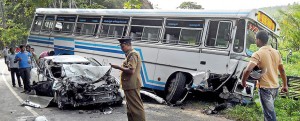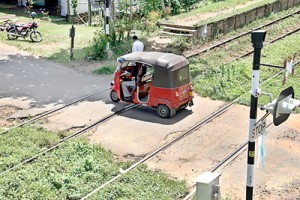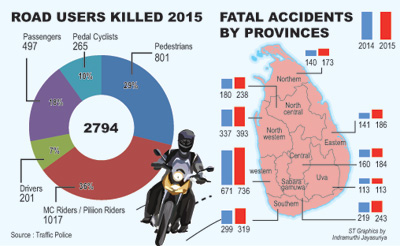Sunday Times 2
Road safety – a matter of life and death
- “One Sri Lankan dies every 3 ½ hours in road accidents
- “The Western Province continues to be most unsafe

In many accidents emotional factors, driving absentmindedly, physical alertness, night fatigue, failure to indicate ones change of direction by means of signals and poor observation of the road scene around are some factors that lead to road accidents with many ending in tragic consequences.
Road accident statistics compiled by the computer division of the Traffic Police reveal that one Sri Lankan is killed in a road accident every 3 ½ hours and twice that number are critically injured. This is a clear indication that road travel is becoming increasingly dangerous and hazardous. Compared to road deaths in the pre 1970s the risk of road deaths faced by Sri Lankans has nearly trebled. Such a tragic scenario is inevitable with higher volumes and variety of traffic moving on an inadequate road network. The capacity of the existing road network is totally incapable of accommodating the varying demands, volumes and mix of road usage. There is a dire need for the State to bring about an overall improvement to the road network. This is to be complemented by an integrated road safety enforcement system. This should also be coupled with an efficient and a convenient mode of public transport. This will then discourage the use of unsafe private modes of travel which would not only ease traffic but minimise road traffic accidents as well.
The above issues are further compounded by several other factors such as the ineffectiveness and lack of uniformity in law enforcement strategies which are presently executed with too much emphasis on traditional methods of static law enforcement. These are totally outdated and incapable of meeting the desired objectives and challenges at hand. An integrated road safety infringement enforcement system needs to be introduced to drastically change driver behaviour as was successfully introduced in the mid 1990s in Victoria, Australia. Singapore and Malaysia are two other countries which brought in such integrated road safety and enforcement campaigns in the 1980s and 1990s. Today’s challenges needs law enforcement to be backed with hi-tech facilities such as speed cameras, red light cameras and CCTV cameras at critical locations. They should also be backed by mobile enforcement adopting covert and overt enforcement strategies along with anti-booze operations carried out on a 24 hour basis. There is also a greater need for tougher laws with rigorous penalties for specific offences as well in the high risk driver category to effectively curb accidents and carnage on roads irrespective of who breaks the law.

The increasing trend in road accidents could be attributed to users callous disrespect for road rules and road manners.
Since three wheelers form a sizeable component in our fleet of vehicles and their driving characteristics to say the least is most incomprehensible, there is a pressing need to enact a rigid three wheeler regulation to mould their “happy go lucky and uncaring ways at the wheel”. This would greatly influence and enhance safety and bring about greater order on roads.
A complete ban on hailing three wheelers on roadsides in the Colombo and Greater Colombo region should be the top priority of the authorities. Picking up passengers should be confined to three wheeler stands only – dropping off passengers may continue to be at the request of the passenger so long as they do not violate basic road rules. This regulation is presently enforced in New Delhi and many other capitals and its introduction in the Metropolitan City of Colombo will be timely and most prudent. To implement such regulations there is a dire need for political will as well as community support.
There is also an urgent and a pressing need for effective road safety awareness campaigns and programs targeting different users at risk. This initiative should be sponsored or backed by all stake holders including insurance companies, agents and dealers of motor vehicles, media institutions, all agencies dealing in the motor trade and of course with the State taking the lead role in backing an effective campaign strategy, as accident costs are a tremendous burden to society in human terms and a huge loss to the country in economic terms.
Since pedestrians continue to be very vulnerable over the years with increased levels of motorisation there is an urgent need to enhance their safety. Unfortunately too little or no attention to safeguard their vulnerability is sufficiently visible. There is an urgent need to look in to the needs of the walking environment by providing – paved sidewalks with guard railings and where appropriate escalators and elevators at under passes, overpasses need to be provided at locations where there is a high demand for pedestrian movement. Some measurers have been introduced recently by the authorities in Colombo with signalized pedestrian crossings and well demarcated crossings but there is a greater need to enhance the safety of pedestrians.
Besides the above mentioned factors the increasing trend in road accidents could also be attributed to the users themselves for their callous disrespect for road rules and road manners which have not been inculcated or ingrained in them at early stages. Their contributions to road accidents in large measure go unnoticed by the enforcement authorities and prosecution is heavily weighted on motorists lapses. Most existing roads also needs to be traffic engineered with built in safety features, improved intersection designs and improved street furniture to discipline and to safeguard road users. Such in-built safety features would enable overcoming some of the existing behavioural patterns on roads and simultaneously bring about greater safety.
 Another approach to reduce accidents is for drivers and riders to be trained to adopt a more responsible attitude to the task of driving and riding with a sound understanding of the hazards prevalent on roads. Traffic conditions and the road environment do not remain stationery, they change continuously and rapidly. This requires a driver to constantly review his driving practices and improve his skills and technique to the demands of traffic. To most the driving licence is the ultimate and neither ones knowledge nor skills mature beyond. But the challenge of driving requires perfecting ones driving and safety attitudes continuously to avoid being involved in a road tragedy and to make driving more pleasant on roads. To achieve these objectives more comprehensive driver training programs should be introduced to incorporate defensive driving techniques and inculcate much needed road manners and safety attitudes. Along with these a more rigid standards of evaluating learner drivers should be established. All this, to be combined with advance driver training and re-training programs should be initiated by the relevant authority along with other stakeholders inclusive of the corporate sector as a social responsibility. These educational programs should also be extended to senior students of schools as well who invariably will be drivers and riders of the future.
Another approach to reduce accidents is for drivers and riders to be trained to adopt a more responsible attitude to the task of driving and riding with a sound understanding of the hazards prevalent on roads. Traffic conditions and the road environment do not remain stationery, they change continuously and rapidly. This requires a driver to constantly review his driving practices and improve his skills and technique to the demands of traffic. To most the driving licence is the ultimate and neither ones knowledge nor skills mature beyond. But the challenge of driving requires perfecting ones driving and safety attitudes continuously to avoid being involved in a road tragedy and to make driving more pleasant on roads. To achieve these objectives more comprehensive driver training programs should be introduced to incorporate defensive driving techniques and inculcate much needed road manners and safety attitudes. Along with these a more rigid standards of evaluating learner drivers should be established. All this, to be combined with advance driver training and re-training programs should be initiated by the relevant authority along with other stakeholders inclusive of the corporate sector as a social responsibility. These educational programs should also be extended to senior students of schools as well who invariably will be drivers and riders of the future.
Factors that determine or lead to road accidents are numerous and varied. They may be attributed to inconsiderate and aggressive driving attitudes, road rage, excessive speed, inappropriate speed, failure to judge speed and distance of other vehicles especially when overtaking and over estimating ones skills and abilities. In many accidents emotional factors, driving absentmindedly, physical alertness, night fatigue, failure to indicate ones change of direction by means of signals and poor observation of the road scene around are some factors that lead to road accidents with many ending in tragic consequences.
A general analysis of road deaths indicates that alcohol impairment, driving at high speeds or inappropriate speeds, fatigue and lack of alertness collectively or singularly were major contributory causes.
A way to overcome most driving violations committed by drivers is to introduce tougher laws and road regulations with severe penalties and stringent law enforcement implemented in a uniform manner. Law enforcement should primarily serve as a deterrent by increasing the road user’s perception of the likely risk of being apprehended by strategies adopted than by the number of infringement notices issued. At the same time penalties should be so structured so that road users fear to commit violations because of the serious consequences one has to confront.
Road deaths in provinces
Province wise the Western Province continues to lead in road accidents and road deaths. Besides rapid motorization in recent years the province continues to have the highest population and with 60% or more of the total vehicle fleet circulating within the province for multitude of reasons. Also over 60% of high profile industries, commercial and school entities are located in this region generating a very high per centage of traffic making the roads in the region more susceptible to accidents and congestion. This coupled with inadequacies in the road network add to congestion and accidents in the region. A primary reason for greater number of accidents occurring in this Province is also the fact that all national roads A1 to A 4 to other Provinces needs to pass through the busiest town centers of this province to and from the City Centre.
The North Western Province comes in as the 2nd highest in road deaths with 415 killed in 393 fatal accidents. This heavy toll is perhaps due to a significant component of vehicles of every description traversing through this province on a daily basis on commercial and leisure trips to the North, North Central, Central and to the Eastern regions. The Province also has a heavy concentration of motor cycles and three wheelers which too contributes in large measure to the high rate of accidents. The roads in this province as well as in other provinces do not have safe overtaking lanes or adequate width for safe overtaking which often leads drivers to take an element of risks when overtaking. Most roads in this province also do not provide adequate safety features for pedestrians and cyclists which make them more vulnerable. A general observation: the high rate of accidents on roads in the provinces could be attributed to excessive speeds and risky overtaking maneuvers often caused by to undue delays en-route, mainly due to heavy volumes of traffic which pass the trunk roads to distant regions. This trend will continue until the expressway network becomes a reality in the country.
The horrendous trend in road accidents will continue unless the authorities responsible and the State in particular offer safety on roads a higher priority in the political agenda under the facet of ‘good governance.’
(The writer is a former DIG in-charge of Traffic Administration and Road Safety)

